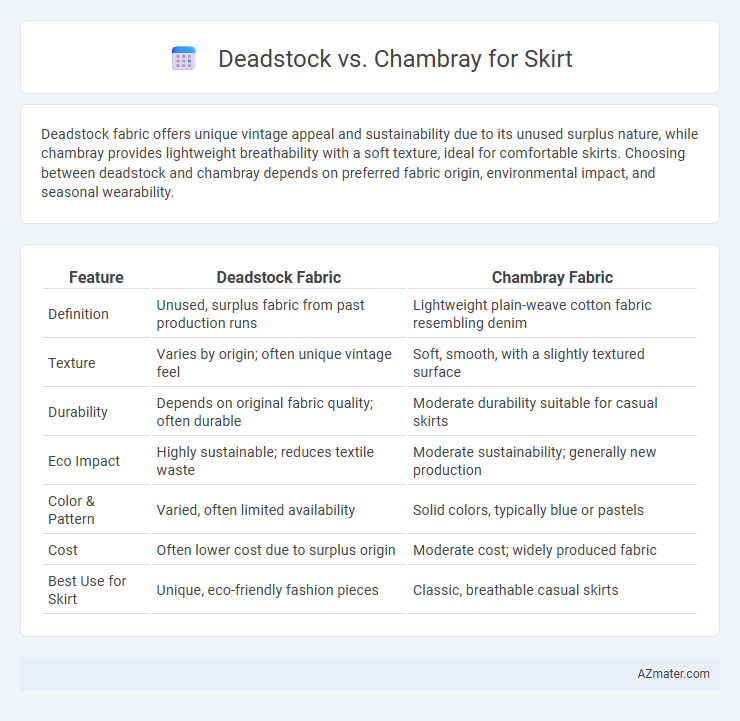Deadstock fabric offers unique vintage appeal and sustainability due to its unused surplus nature, while chambray provides lightweight breathability with a soft texture, ideal for comfortable skirts. Choosing between deadstock and chambray depends on preferred fabric origin, environmental impact, and seasonal wearability.
Table of Comparison
| Feature | Deadstock Fabric | Chambray Fabric |
|---|---|---|
| Definition | Unused, surplus fabric from past production runs | Lightweight plain-weave cotton fabric resembling denim |
| Texture | Varies by origin; often unique vintage feel | Soft, smooth, with a slightly textured surface |
| Durability | Depends on original fabric quality; often durable | Moderate durability suitable for casual skirts |
| Eco Impact | Highly sustainable; reduces textile waste | Moderate sustainability; generally new production |
| Color & Pattern | Varied, often limited availability | Solid colors, typically blue or pastels |
| Cost | Often lower cost due to surplus origin | Moderate cost; widely produced fabric |
| Best Use for Skirt | Unique, eco-friendly fashion pieces | Classic, breathable casual skirts |
Introduction: Deadstock vs Chambray for Skirt Making
Deadstock fabric offers sustainable, limited-edition material choices that add unique character and eco-friendly appeal to skirt making. Chambray, known for its lightweight, breathable texture and subtle denim look, provides comfort and versatility in skirt designs. Selecting between deadstock and chambray involves weighing sustainability and exclusivity against classic style and wearability.
What is Deadstock Fabric?
Deadstock fabric refers to surplus or leftover textile stock that was never sold or used, often originating from past fashion productions or discontinued lines. It offers a sustainable and unique option for skirt making, characterized by rare patterns and high-quality materials that are no longer widely available. Compared to chambray, which is a lightweight plain-weave cotton fabric known for its soft texture and denim-like appearance, deadstock fabric provides distinct vintage appeal and eco-conscious value in skirt design.
Defining Chambray: Characteristics and Appeal
Chambray is a lightweight, plain-weave fabric made from cotton or cotton blends, characterized by its soft texture and subtle color variation from colored warp and white weft threads. Its breathable, comfortable nature and slightly faded look lend skirts a casual yet refined appeal, perfect for warm weather and versatile styling. Unlike deadstock fabric, chambray is valued for its consistent availability and timeless aesthetic, making it a popular choice for durable, everyday skirts.
Sustainability: Deadstock vs Chambray Environmental Impact
Deadstock fabric reduces waste by repurposing surplus textiles that would otherwise end up in landfills, making it a highly sustainable choice for skirts. Chambray, often cotton-based and biodegradable, offers environmental benefits but requires resource-intensive farming practices that impact water use and soil health. Choosing deadstock skirts supports circular fashion by minimizing fabric production demand and promoting waste reduction compared to new chambray fabric.
Texture and Feel: Comparing Deadstock and Chambray
Deadstock fabric often features a unique, vintage texture with a slightly stiffer and more durable feel, ideal for structured skirts that hold shape well. Chambray offers a soft, lightweight texture with a smooth, breathable surface, providing comfort and a relaxed, casual drape suitable for everyday wear. The choice between deadstock and chambray depends on the desired skirt silhouette and tactile experience, balancing durability against softness.
Style Versatility: How Each Fabric Elevates Skirt Design
Deadstock fabric brings a unique vintage appeal to skirts, offering rich textures and rare patterns that elevate design with timeless character and sustainability. Chambray provides a lightweight, breathable texture that enhances skirt versatility, easily transitioning from casual daywear to polished evening looks. Both fabrics allow designers to experiment with drape and structure, but deadstock lends an artisanal touch while chambray emphasizes comfort and modern minimalism.
Durability: Long-Term Performance of Deadstock and Chambray Skirts
Deadstock skirts, made from unused vintage fabrics, often boast exceptional durability due to their high-quality natural fibers and traditional weaving techniques. Chambray skirts, woven from lightweight cotton with a plain weave, offer moderate durability but enhance comfort and breathability for everyday wear. Over the long term, deadstock skirts tend to maintain shape and resist wear better, making them ideal for durable, sustainable fashion.
Pricing and Accessibility: Cost Differences Explained
Deadstock skirts often come at a higher price due to their limited availability and vintage appeal, making them a unique investment piece. Chambray skirts are generally more affordable and widely accessible, crafted from lightweight cotton that mimics denim but offers greater breathability. Pricing disparities reflect the rarity of deadstock fabrics compared to the mass-produced nature of chambray, influencing budget considerations for shoppers.
Best Uses: Choosing the Right Fabric for Your Skirt
Deadstock fabric offers a unique, sustainable choice for skirts with its vintage appeal and often high-quality natural fibers, ideal for statement pieces and limited-edition designs. Chambray, known for its lightweight, breathable cotton blend and soft denim-like appearance, is perfect for casual, everyday skirts that require comfort and ease of movement. Selecting between deadstock and chambray depends on whether you prioritize eco-conscious fashion with a distinct look or versatile, comfortable wearability for daily use.
Conclusion: Which Material Suits Your Skirt Needs?
Deadstock fabric offers eco-friendly, unique textiles ideal for sustainable, one-of-a-kind skirts with rich textures and limited availability. Chambray provides lightweight, breathable comfort and a versatile denim-like appearance perfect for casual or semi-formal skirts requiring durability and easy maintenance. Choose deadstock for exclusive, environmentally conscious fashion and chambray for functional, everyday wear adaptable to multiple styles.

Infographic: Deadstock vs Chambray for Skirt
 azmater.com
azmater.com